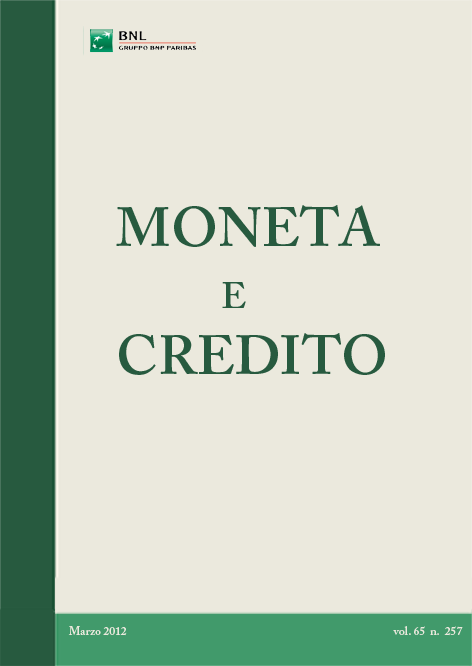La crisi della macroeconomia. (The Crisis of Macroeconomics)
DOI:
https://doi.org/10.13133/2037-3651/9502Keywords:
macroeconomic equilibrium, representative agent, financial markets.Abstract
The DSGE models are based on hypotheses that have the effect of excluding the possibility of severe financial and economic crises with the consequent policy implications going in the laissez-faire direction. The hypothesized unique and stable equilibrium in combination with rational expectations allow the conclusion that a built-in process of quick self-regulation operates in the economic system. The assumptions of a unique representative agent and of the efficiency of financial markets (when they are considered in the model) exclude any possibility of agents too much indebted, of bank failures, of liquidity and credit crunch crises. A single model cannot give an adequate explanation of the alternation of paths of substantial equilibrium and of strong disequilibrium. Hence the paper ends with the proposal to utilize a number of sub-models each one of them entering in function when some parameters come to assume certain values and being discarded, in favour of a different sub-model, when the parameters assume other values.
JEL: E12, E13, E32, E44, G14
References
AKERLOF G.A. e SHILLER R.J. (2009), Anima Spirits, Princeton University Press, Princeton.
ARROW K.J. e DEBREU G. (1954), "Existence of Equilibrium for a Competitive Economy", Econometrica, vol. 22 n. 3, pp. 265-290.
CHARI V.V. e KEHOE P.J. (2006), "Modern Macroeconomics in Practice: how Theory is Shaping Policy", Journal of Economic Perspectives, vol. 20 n. 4, pp. 3-28.
CHARI V.V., KEHOE P.J. e MCGRATTAN E.R. (2009), "New Keynesian models: not yet useful for policy analysis", American Economic Journal: Macroeconomics, vol. 1 n. 1, pp. 242-266.
COZZI T. (1998), "Discussion", in RAMPA G., STELLA L. e THIRLWALL A., (a cura di), Economic Dynamics: Trade and Growth, Macmillan, London, pp. 33-37.
COZZI T. (2009), "La teoria della crescita e la scuola keynesiana di Cambridge", relazione al convegno Gli economisti postkeynesiani di Cambridge e l’Italia, Roma, 11-12
arzo.
GOODHART C. (2009), "The Unfortunate Uselessness of most ‘State of the Art’ Academic Monetary Economics", disponibile online alla URL: http://www.ft.com/ maverecon/2009/03.
HARROD R.F. (1970), "Harrod after Twenty-one Years: a Comment", Economic Journal, vol. 80 n. 319, pp. 737-741.
HARROD R.F. (1973), Economic dynamics, Macmillan, London.
KIRMAN A.P. (1992), "Whom or what does the Representative Individual Represent?", Journal of Economic Perspectives, vol. 6 n. 2, pp. 117-136.
LEIJONHUFVUD A. (1973), "Effective Demand Failures", Swedish Economic Journal, vol. 75 n. 1, pp. 27-48.
LEIJONHUFVUD A. (2009), "Macroeconomics and the Crisis: a Personal Appraisal", CEPR Policy Insight, n. 41.
MINSKY H.P. (1984), Potrebbe ripetersi?, Einaudi, Torino.
RAMSEY F.P. (1928), "A Mathematical Theory of Saving", Economic Journal, vol. 38 n. 152, pp. 543-559.
SOLOW R.M. (1956), "A Contribution to the Theory of Economic Growth", Quarterly Journal of Economics, vol. 70 n.1, pp. 65-94.
SOLOW R.M. (2008), "The state of Macroeconomics", Journal of Economic Perspectives, vol. 22 n. 1, pp. 243-246.
TOBIN J. (1984), "On the Efficiency of the Financial System", Lloyds Bank Review, vol. 153, pp. 1-15.
WOODFORD M. (2009), "Convergence in macroeconomics. Elements of the new synthesis", American Economic Journal: Macroeconomics, vol. 1 n. 1, pp. 267-279.
Downloads
Published
Issue
Section
License
All material in this website and every article published by the review are licensed under a Creative Commons Attribution - Non commercial - No derivates 4.0 International license. Authors retain all rights on their works and grant the right to first publication to the review under the aforementioned license.


